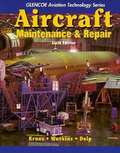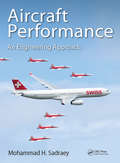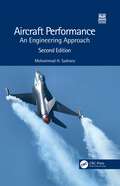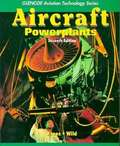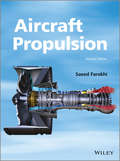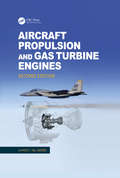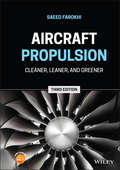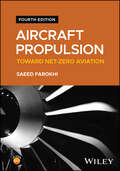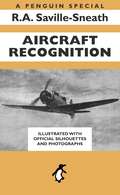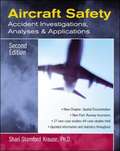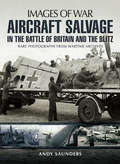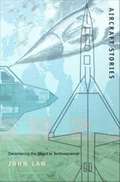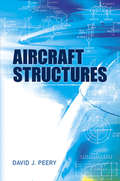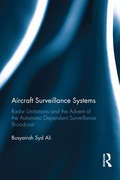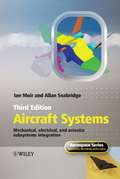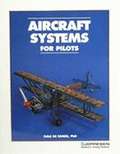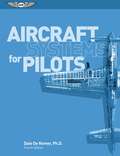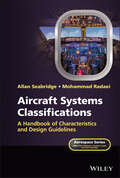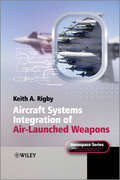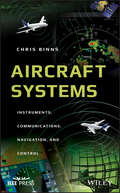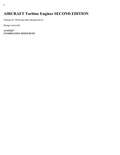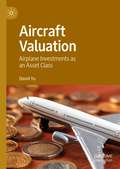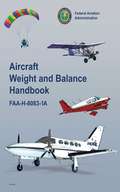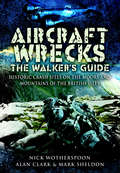- Table View
- List View
Aircraft Maintenance and Repair (6th Edition)
by Michael J. Kroes William A. Watkins Frank DelpThis text is one of five that compose the Glencoe Aviation Technology Series. Like all of the titles in this series, this text provides coverage of practical skills while building a foundation for more advanced learning. It offers a thorough presentation of all aspects of aircraft maintenance and repair, including information on new materials, structures, systems, and processes. This edition includes all the theoretical and practical information that students need for certification as FAA airframe technicians in accordance with Federal Aviation Regulations (FAR). In preparing the Sixth Edition, the authors reviewed FAR Parts 65 and 147 and appropriate Advisory Circulars, as well as related Federal Aviation Regulations.
Aircraft Performance: An Engineering Approach
by Mohammad H. SadraeyAircraft Performance: An Engineering Approach introduces flight performance analysis techniques that enable readers to determine performance and flight capabilities of aircraft. Flight performance analysis for prop-driven and jet aircraft is explored, supported by examples and illustrations, many in full color. MATLAB programming for performance analysis is included, and coverage of modern aircraft types is emphasized. The text builds a strong foundation for advanced coursework in aircraft design and performance analysis.
Aircraft Performance: An Engineering Approach
by Mohammad H. SadraeyAircraft Performance: An Engineering Approach, Second Edition introduces flight performance analysis techniques of fixed-wing air vehicles, particularly heavier-than-aircraft. It covers maximum speed, absolute ceiling, rate of climb, range, endurance, turn performance, and takeoff run.Enabling the reader to analyze the performance and flight capabilities of an aircraft by utilizing only the aircraft weight data, geometry, and engine characteristics, this book covers the flight performance analysis for both propeller-driven and jet aircraft. The second edition features new content on vertical takeoff and landing, UAV launch, UAV recovery, use of rocket engine as the main engine, range for electric aircraft, electric engine, endurance for electric aircraft, gliding flight, pull-up, and climb-turn. In addition, this book includes end-of-chapter problems, MATLAB® code and examples, and case studies to enhance and reinforce student understanding.This book is intended for senior undergraduate aerospace students taking courses in Aircraft Performance, Flight Dynamics, and Flight Mechanics.Instructors will be able to utilize an updated Solutions Manual and Figure Slides for their course.
Aircraft Powerplants (7th Edition)
by Michael J. Kroes Thomas W. WildAircraft Powerplants, Seventh Edition, part of the Glencoe Aviation Technology Series (formerly the Northrop Series), is the most comprehensive up-to-date powerplant book on the market today. It has been revised to reflect the latest changes in FAR Part 147 and changing industry needs. The new edition features expanded coverage of turbine engine theory and nomenclature. It also includes additional current models of turbofan, turboprop, and turboshaft engines. Information on turbine engine fuel, oil, ignition systems has been expanded and divided into separate chapters. And the remainder of the turbine engine material is updated and presented apart from reciprocating engines, allowing for the flexibility of teaching this materials separately or together.
Aircraft Propulsion
by Saeed FarokhiNew edition of the successful textbook updated to include new material on UAVs, design guidelines in aircraft engine component systems and additional end of chapter problemsAircraft Propulsion, Second Edition is a comprehensive textbook covering aircraft gas turbine engine and rocket propulsion from the basic principles to more advanced treatments in engine components. Propulsion system integration with aircraft plays an important role in understanding propulsion and is addressed accordingly. Extensive review material and derivations are included to help the reader navigate through the subject with more ease. In every engine component, issues related to manufacturing, material properties, temperature limitations and cooling are included to give an appreciation for the broader scope of propulsion engineering than just aero-thermodynamics. Component matching and off-design analysis is detailed in a separate chapter to provide the physical and performance linkage between the components and their impact on aircraft engines. Principles of chemical rocket propulsion are presented in the context of single-stage to orbit propulsion needs of a rocket-based combined cycle vehicle.The new edition of this textbook has been updated to include a new chapter on UAV propulsion, and the design guidelines in aircraft engine component systems have been expanded to make the book user friendly for component designers. New material on drop?]in biofuels and design for sustainability is also included to reflect FAA's 2025 Vision. Numerous end of chapter problems are included and a solutions manual is available on a companion website.New edition of the successful textbook updated to include new material on UAVs, design guidelines in aircraft engine component systems and additional end of chapter problemsContains over 100 examples designed to practice the principles learned in jet propulsion and compliment learning through applicationsCovers aircraft gas turbine engine and rocket propulsion from the basic principles to more advanced treatments in engine componentsConsiders propulsion system integration with aircraftAccompanied by a website hosting a solutions manualAn excellent textbook for Graduate and undergraduate students in aerospace and mechanical engineering.
Aircraft Propulsion and Gas Turbine Engines, Second Edition
by Ahmed F. El-SayedAircraft Propulsion and Gas Turbine Engines, Second Edition builds upon the success of the book’s first edition, with the addition of three major topic areas: Piston Engines with integrated propeller coverage; Pump Technologies; and Rocket Propulsion. The rocket propulsion section extends the text’s coverage so that both Aerospace and Aeronautical topics can be studied and compared. Numerous updates have been made to reflect the latest advances in turbine engines, fuels, and combustion. The text is now divided into three parts, the first two devoted to air breathing engines, and the third covering non-air breathing or rocket engines.
Aircraft Propulsion: Cleaner, Leaner, and Greener
by Saeed FarokhiExplore the latest edition of a leading resource on sustainable aviation, alternative jet fuels, and new propulsion systems The newly revised Third Edition of Aircraft Propulsion delivers a comprehensive update to the successful Second Edition with a renewed focus on the integration of sustainable aviation concepts. The book tackles the impact of aviation on the environment at the engine component level, as well as the role of propulsion system integration on fuel burn. It also discusses combustion emissions, including greenhouse gases, carbon monoxide, unburned hydrocarbons (UHC), and oxides of nitrogen (NOx). Alternative jet fuels, like second generation biofuels and hydrogen, are presented. The distinguished author covers aviation noise from airframe to engine and its impact on community noise in landing and takeoff cycles. The book includes promising new technologies for propulsion and power, like the ultra-high bypass (UHB) turbofan and hybrid-electric and electric propulsion systems. Readers will also benefit from the inclusion of discussions of unsteady propulsion systems in wave-rotor combustion and pulse-detonation engines, as well as: A thorough introduction to the history of the airbreathing jet engine, including innovations in aircraft gas turbine engines, new engine concepts, and new vehicles An exploration of compressible flow with friction and heat, including a brief review of thermodynamics, isentropic process and flow, conservation principles, and Mach numbers A review of engine thrust and performance parameters, including installed thrust, rocket thrust, and modern engine architecture A discussion of gas turbine engine cycle analysis Perfect for aerospace and mechanical engineering students in the United States and overseas, Aircraft Propulsion will also earn a place in the libraries of practicing engineers in the aerospace and green engineering sectors seeking the latest up to date resource on sustainable aviation technologies.
Aircraft Propulsion: Toward Net-Zero Aviation
by Saeed FarokhiUpdated edition of the successful textbook exploring cutting-edge developments in the field and Net-Zero aviation goals of 2050 Maintaining the successful foundation of previous editions, the fourth edition of Aircraft Propulsion is a forward-looking textbook on propulsion, from the basic principles to more advanced treatments in engine components and system integration, that focuses on the Net-Zero Aviation goals of 2050. This book explores the alphabet of the emerging technology in propulsion by emphasizing electrification and sustainable aviation fuels (SAF), including liquefied natural gas (LNG) and hydrogen. This book also covers advanced topics like flow control, adaptive cycle engines (ACE), hybrid-electric propulsion, pulse detonation engines (PDE), propulsion integration, and engine performance testing and instrumentation. Along with content updates, this new edition devotes a new chapter to supersonic and hypersonic propulsion. End-of-chapter problem sets are included as a learning aid with solutions available on a companion website. A quiz appendix with 45 10-minute quizzes helps readers test their knowledge at every stage of learning. Aircraft Propulsion includes information on: Engine thrust and performance parameters, gas turbine engine cycle analysis, and aircraft engine inlets and nozzles Combustion chambers and afterburners, axial-flow compressor and fan aerodynamics, centrifugal compressor aerodynamics and gas turbine aerodynamics, and heat transfer and cooling technologies Aircraft engine component matching and off-design analysis Available on a companion website: Compressible flow with friction and heat, general aviation and uninhabited aerial vehicle propulsion systems, propeller theory, and chemical rocket propulsion Aircraft Propulsion is an essential reference on the subject for aerospace and mechanical engineering students in their upper undergraduate or first-year graduate studies, practicing engineers in industry and research centers working on sustainability, and aviation industry engineers.
Aircraft Recognition: A Penguin Special
by R.A. Saville-SneathWhen this book was first published in 1941, aircraft recognition was far more than just a pleasant pastime; it was often a matter of life and death… This classic text provides a definitive catalogue of the aeroplanes, enemy and friendly, seen over British skies during the Second World War. R.A. Saville-Sneath set out to produce a handy classification guide, with many diagrams, a full glossary and some useful mnemonics, showing how each type of aircraft could be identified quickly and easily. The basic structures, tail units, positions of the wings and engines, and even the sounds made by the different planes, form part of the essential 'vocabulary' for distinguishing Albacores and Ansons, Beauforts and Blenheims, Heinkels, Hurricanes and Junkers, Messerschmitts and Moths, Spitfires and Wellingtons. For anyone interested in aviation the book provides a mine of information about a golden age. For those who lived through one of the most glorious episodes in the history of combat it will prove vividly evocative of those extraordinary days.
Aircraft Safety: Accident Investigations, Analyses, and Applications, 2nd Editions
by Shari Stamford KrauseThe contents of this book present a unique blend of research material and instructional guidelines against the backdrop of actual aircraft accident cases with a view to provide pilots and aviation professionals, regardless of experience levels, the clear and realistic lessons that have evolved from these accidents. The book is divided into five comprehensive parts: Human Factors, Runway Incursions, Weather, Mid-Air Collisions, and Mechanical and Maintenance.
Aircraft Salvage in the Battle of Britain and the Blitz: Aircraft Salvage in the Battle of Britain and the Blitz (Images Of War Bks.)
by Andy SaundersAircraft Salvage in the Battle of Britain and Blitz will comprise of some 140-150 images of the work of RAF and civilian salvage squads during the Battle of Britain, the Blitz and beyond. The images will depict losses across Britain, both RAF and German, during this period. Each picture will tell its own story, and will be fully captioned with historical detail. The author will be covering a topic that has rarely been examined in this detail.Each section will have a short introduction and the images will include those of shot down aircraft, including relatively intact machines, badly damaged/destroyed wreckages, photographs of pilots and other related illustrations. All images are from the authors unique collection of wartime photographs of Luftwaffe losses, collected from a variety of sources across some thirty-five years of research.
Aircraft Stories: Decentering the Object in Technoscience
by John LawIn Aircraft Stories noted sociologist of technoscience John Law tells "stories" about a British attempt to build a military aircraft--the TSR2. The intertwining of these stories demonstrates the ways in which particular technological projects can be understood in a world of complex contexts. Law works to upset the binary between the modernist concept of knowledge, subjects, and objects as having centered and concrete essences and the postmodernist notion that all is fragmented and centerless. The structure and content of Aircraft Stories reflect Law's contention that knowledge, subjects, and--particularly-- objects are "fractionally coherent": that is, they are drawn together without necessarily being centered. In studying the process of this particular aircraft's design, construction, and eventual cancellation, Law develops a range of metaphors to describe both its fractional character and the ways its various aspects interact with each other. Offering numerous insights into the way we theorize the working of systems, he explores the overlaps between singularity and multiplicity and reveals rich new meaning in such concepts as oscillation, interference, fractionality, and rhizomatic networks. The methodology and insights of Aircraft Stories will be invaluable to students in science and technology studies and will engage others who are interested in the ways that contemporary paradigms have limited our ability to see objects in their true complexity.
Aircraft Structures (Dover Books on Aeronautical Engineering)
by David J. PeeryStill relevant decades after its 1950 publication, this legendary reference text on aircraft stress analysis is considered the best book on the subject. It emphasizes basic structural theory, which remains unchanged with the development of new materials and construction methods, and the application of the elementary principles of mechanics to the analysis of aircraft structures. Suitable for undergraduate students, this volume covers equilibrium of forces, space structures, inertia forces and load factors, shear and bending stresses, and beams with unsymmetrical cross sections. Additional topics include spanwise air-load distribution, external loads on the airplane, joints and fittings, deflections of structures, and special methods of analysis. Topics involving a knowledge of aerodynamics appear in final chapters, allowing students to study the prerequisite aerodynamics topics in concurrent courses.
Aircraft Surveillance Systems: Radar Limitations and the Advent of the Automatic Dependent Surveillance Broadcast
by Busyairah Syd AliThe Communication, Navigation and Surveillance (CNS) systems provide air traffic controllers with the information necessary to ensure the specified separation between aircraft and efficient management of airspace, as well as assistance to flight crew for safe navigation. However, the radar systems that support air traffic management (ATM), and in particular air traffic control (ATC), are at their operational limit. This is particularly acute in the provision of the ATC services in low altitude, remote and oceanic areas. Limitations in the current surveillance systems include unavailability of services in oceanic and remote areas, limited services during extreme weather conditions, and outdated equipment with limited availability of spare parts to support system operation. These limitations have resulted in fatal accidents. This book addresses the limitations of radar to support ATC in various operational environments, identified and verified by analysing five years of safety data from Avinor, the Air Navigation Service Provider (ANSP) in Norway. It derives a set of taxonomy and from this develops a causal model for incident/accident due to limitations in the surveillance system. The taxonomy provides a new method for ANSPs to categorize incidents while the causal model is useful for incident/accident investigations. The book also provides theoretical justifications for the use of Automatic Dependent Surveillance Broadcast (ADS-B) to overcome the limitations of radar systems and identify areas of improvements to enable seamless ATC services. Written in a style that makes it accessible to non-specialists, Aircraft Surveillance Systems will be of interest to many in the field of aviation, particularly ATM, safety and accident/incident investigation. It will also offer a useful reference on this vital topic for air traffic management courses.
Aircraft Systems
by Ian Moir Allan SeabridgeThis third edition of Aircraft Systems represents a timely update of the Aerospace Series' successful and widely acclaimed flagship title. Moir and Seabridge present an in-depth study of the general systems of an aircraft - electronics, hydraulics, pneumatics, emergency systems and flight control to name but a few - that transform an aircraft shell into a living, functioning and communicating flying machine. Advances in systems technology continue to alloy systems and avionics, with aircraft support and flight systems increasingly controlled and monitored by electronics; the authors handle the complexities of these overlaps and interactions in a straightforward and accessible manner that also enhances synergy with the book's two sister volumes, Civil Avionics Systems and Military Avionics Systems.Aircraft Systems, 3rd Edition is thoroughly revised and expanded from the last edition in 2001, reflecting the significant technological and procedural changes that have occurred in the interim - new aircraft types, increased electronic implementation, developing markets, increased environmental pressures and the emergence of UAVs. Every chapter is updated, and the latest technologies depicted. It offers an essential reference tool for aerospace industry researchers and practitioners such as aircraft designers, fuel specialists, engine specialists, and ground crew maintenance providers, as well as a textbook for senior undergraduate and postgraduate students in systems engineering, aerospace and engineering avionics.
Aircraft Systems For Pilots
by Dale De RemerThe most comprehensive book available on aircraft systems as they relate to pilots and pilot training. Covers all system types in detail. Excellent for commercial and advence pilot programs, as well as for the individual who wants to be well versed in how airplanes really work.
Aircraft Systems For Pilots
by Dale De RemerThis book is a single source, concise presentation of what pilots should know about basic aircraft systems. The content reflects the author’s more than thirty-five years experience of flying and fourteen years of teaching Aircraft Systems to university students. <P><P>Aircraft Systems for Pilots includes a brief study of the fundamentals of physical matter (from which airplanes are made) and mechanics (how airplane parts act and react). The author provides sufficient study of each type of system to allow the professional pilot to stay abreast of the critical learning which must occur as the pilot advances into management of more complex aircraft. <P><P>Subject covered include physics, aircraft engine types and construction, reciprocating engine theory of operation, engine lubrication and cooling, propellers and governors, fuels and fuel systems, power management, supercharging and turbocharging, pressurization and high altitude operations, electrical principles, electrical components, aircraft electrical systems, hydraulic systems and landing gear, pneumatic and deicing systems, aircraft structures and flight controls, weight and balance, inspections, pilot maintenance, and aircraft instrument systems. Illustrated throughout, study questions conclude each chapter and includes index. <P><P>In print for more than 30 years and continually updated through the years, this 4th Edition continues to serve as the comprehensive college textbook for pilots learning aircraft systems.
Aircraft Systems Handbook: A Guide to Key Characteristics and Requirements (Aerospace Series)
by Allan SeabridgeAircraft Systems Classifications Enables aerospace professionals to quickly and accurately reference key information about all types of aircraft systems Aircraft Systems Classifications: A Handbook of Characteristics and Design Guidelines provides comprehensive information on aircraft systems delivered in a concise, direct, and standardized way, allowing readers to easily find the information they need. The book presents a full set of characteristics and requirements for all types of aircraft systems, including avionic, mission, and supporting ground systems, in a single volume. Readers can delve further into specific topics by referencing the detailed glossary and bibliography. To aid in reader comprehension, each aircraft system is broken down according to various criteria, such as: Purpose, description, and safety Integration with other systems Key interfaces and design drivers Modeling and simulation Best practices and future trends Written for aerospace professionals, researchers, and advanced students with some existing knowledge of the aircraft industry, this book allows readers to quickly reference information on every aspect of aircraft systems.
Aircraft Systems Integration of Air-Launched Weapons
by Keith A. RigbyFrom the earliest days of aviation where the pilot would drop simple bombs by hand, to the highly agile, stealthy aircraft of today that can deliver smart ordnance with extreme accuracy, engineers have striven to develop the capability to deliver weapons against targets reliably, safely and with precision. Aircraft Systems Integration of Air-Launched Weapons introduces the various aspects of weapons integration, primarily from the aircraft systems integration viewpoint, but also considers key parts of the weapon and the desired interactions with the aircraft required for successful target engagement. Key features:Addresses the broad range of subjects that relate directly to the systems integration of air-launched weapons with aircraft, such as the integration process, system and subsystem architectures, the essential contribution that open, international standards have on improving interoperability and reducing integration costs and timescalesDescribes the recent history of how industry and bodies such as NATO have driven the need for greater interoperability between weapons and aircraft and worked to reduce the cost and timescales associated with the systems integration of complex air-launched weapons with aircraftExplores future initiatives and technologies relating to the reduction of systems integration costs and timescalesThe systems integration of air-launched weapons with aircraft requires a multi-disciplinary set of engineering capabilities. As a typical weapons integration life-cycle spans several years, new engineers have to learn the skills required by on-the-job training and working with experienced weapons integrators. Aircraft Systems Integration of Air-Launched Weapons augments hands-on experience, thereby enabling the development of subject matter expertise more quickly and in a broader context than would be achieved by working through the life-cycle on one specific project. This book also serves as a useful revision source for experienced engineers in the field.
Aircraft Systems: Instruments, Communications, Navigation, and Control (Wiley - IEEE)
by Chris BinnsAn authoritative guide to the various systems related to navigation, control, and other instrumentation used in a typical aircraft Aircraft Systems offers an examination of the most recent developments in aviation as it relates to instruments, radio navigation, and communication. Written by a noted authority in the field, the text includes in-depth descriptions of traditional systems, reviews the latest developments, as well as gives information on the technologies that are likely to emerge in the future. The author presents material on essential topics including instruments, radio propagation, communication, radio navigation, inertial navigation, and puts special emphasis on systems based on MEMS. This vital resource also provides chapters on solid state gyroscopes, magnetic compass, propagation modes of radio waves, and format of GPS signals. Aircraft Systems is an accessible text that includes an investigation of primary and secondary radar, the structure of global navigation satellite systems, and more. This important text: Contains a description of the historical development of the latest technological developments in aircraft instruments, communications and navigation Gives several “interesting diversion” topics throughout the chapters that link the topics discussed to other developments in aerospace Provides examples of instruments and navigation systems in actual use in cockpit photographs obtained during the authors work as a flight instructor Includes numerous worked examples of relevant calculations throughout the text and a set of problems at the end of each chapter Written for upper undergraduates in aerospace engineering and pilots in training, Aircraft Systems offers an essential guide to both the traditional and most current developments in aviation as it relates to instruments, radio navigation, and communication.
Aircraft Turbine Engines
by Thomas W. Wild John Michael DavisAircraft Turbine Engines. Professors Wild and Davis, both of Purdue University, have updated the classic Aircraft Turbine Engines textbook to create the second edition. This new edition contains the latest in turbine engine technology and manufacturing practices. Of course, it still covers the unchanging principles of heat engines, performance factors, and all the terminology that goes with them. <p><p>This book was written for powerplant technicians and crewmembers who service, maintain, and operate gas turbine engines used on today’s aircraft. Comprehensive diagrams and images are used throughout the text to illustrate key concepts. Turbine engine practices and techniques provide background information on standard industry practices. Turbofan, turboprop, and turboshaft engines are explored, emphasizing their differences and how they fulfill unique requirements. Example engine models are explored in detail for each type. Readers can easily understand engine systems and components and their function as part of the overall engine operation.
Aircraft Valuation in Volatile Market Conditions: Guiding Toward Profitability and Prosperity (Management for Professionals)
by Bijan Vasigh Farshid AzadianThis book provides indispensable knowledge for practitioners in aircraft financing. It presents an innovative framework that treats valuation analysis as a systematic effort in problem-solving directed at rational financial decision-making. It incorporates much of the modern approach to financial investment decision-making. It proposes essential tools of flexibility, adaptability, and commonality of aircraft financial analyses that apply to an almost infinite variety of valuation problem situations. Once these connections have been introduced, the reader will be equipped with an understanding of the underlying concepts of aircraft valuation processes and techniques and the subsequent financing alternatives available to fund aircraft assets. This is an essential book for airline professionals, aircraft leasing companies, consultants, bankers, government officials, and students of aircraft finance. It is an approachable resource for those without a formal background in finance.
Aircraft Valuation: Airplane Investments as an Asset Class
by David YuThis book is one of the first to explore aviation and aircraft leasing and its values establishing it as a standalone investable asset class within the larger real assets industry. Airplanes are a crucial but capital-intensive component of the global economy. The author, as an academic, researcher, appraiser, advisor and businessperson in the industry, bridges a gap in the existing literature with his analysis of the underlying aviation asset class return and risk profile. The book describes the characteristics, dynamics and drivers of the global, Asia and China specific aviation and leasing landscapes. Recent effects of COVID-19 on aviation and an analysis of the drivers affecting cross border mergers and acquisitions in the industry are also investigated. The book includes 20+ years of empirical aircraft valuation evidence and analysis of its characteristics establishing the aircraft and sub-segments as asset classes. In addition, characteristic comparisons to other real asset subclasses and benchmarks are examined. This book will be of interest to academics, financiers, investors, industry participants and more general aviation enthusiasts.
Aircraft Weight and Balance Handbook: FAA-H-8083-1A (Faa Reprints Ser.)
by Federal Aviation AdministrationThe Aircraft Weight and Balance Handbook is the official U.S. government guidebook for pilots, flight crews, and airplane mechanics. Beginning with the basic principles of aircraft weight and balance control, this manual goes on to cover in exacting detail the procedures for weighing aircraft. It also offers a thorough discussion of the methods used to determine the location of an aircraft's empty weight and center of gravity (CG), including information for an A&P mechanic to determine weight changes caused by repairs or alterations. With instructions for conducting adverse-loaded CG checks and for determining the amount and location of ballast needed to bring CG within allowable limits, the Aircraft Weight and Balance Handbook is essential for anyone who wishes to safely weigh and fly aircraft of all kinds.
Aircraft Wrecks: Historic Crash sites on the Moors and Mountains of the British Isles
by Alan Clark Nick Wotherspoon Mark SheldonThis book gives readers a direct link to crash sites that can be visited, with accurate grid references, site description and current photographs. It covers some 450 selected sites with emphasis given to those on open access land. The areas covered are: Southern England: Dartmoor and Exmoor 20 entries * Wales 120 entries * Isle of Man 20 entries Peak District 75 entries * Yorkshire Moors: Eastern 20 entries * Lake District 25 entriesPennines: East Lancashire & West Yorkshire * Scotland: Central and Southern 30 entriesScotland: Highlands & Islands * Ireland 20 entries Each area includes a preamble describing the local geography and historical notes. Individual site entries include exact location, details of the aircraft and crew and the circumstances of the loss.
